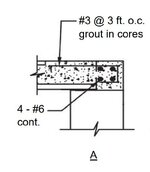Hello all,
Looking to see what works better in terms of the design of a diaphragm chord in a building constructed with hollow-core slabs, CFS stud walls as load bearing walls and cast-in-place concrete shear walls. The two options I am thinking of are:
1- CFS straps at the edges of the slabs.
2- Use the tracks of the CFS studs.
In both options, the chord needs to be continuous. How best to make CFS straps or tracks continuous? is welding a common practices with CFS? If welding is an option, what type of welding or notes are needed to be included on the drawings? I never specified welding for CFS before.
If we use splicing plate/strap to make the chord continuous, we could end up with so many screws to connect the two sides. What did you do?
Thanks for the input.
Looking to see what works better in terms of the design of a diaphragm chord in a building constructed with hollow-core slabs, CFS stud walls as load bearing walls and cast-in-place concrete shear walls. The two options I am thinking of are:
1- CFS straps at the edges of the slabs.
2- Use the tracks of the CFS studs.
In both options, the chord needs to be continuous. How best to make CFS straps or tracks continuous? is welding a common practices with CFS? If welding is an option, what type of welding or notes are needed to be included on the drawings? I never specified welding for CFS before.
If we use splicing plate/strap to make the chord continuous, we could end up with so many screws to connect the two sides. What did you do?
Thanks for the input.

